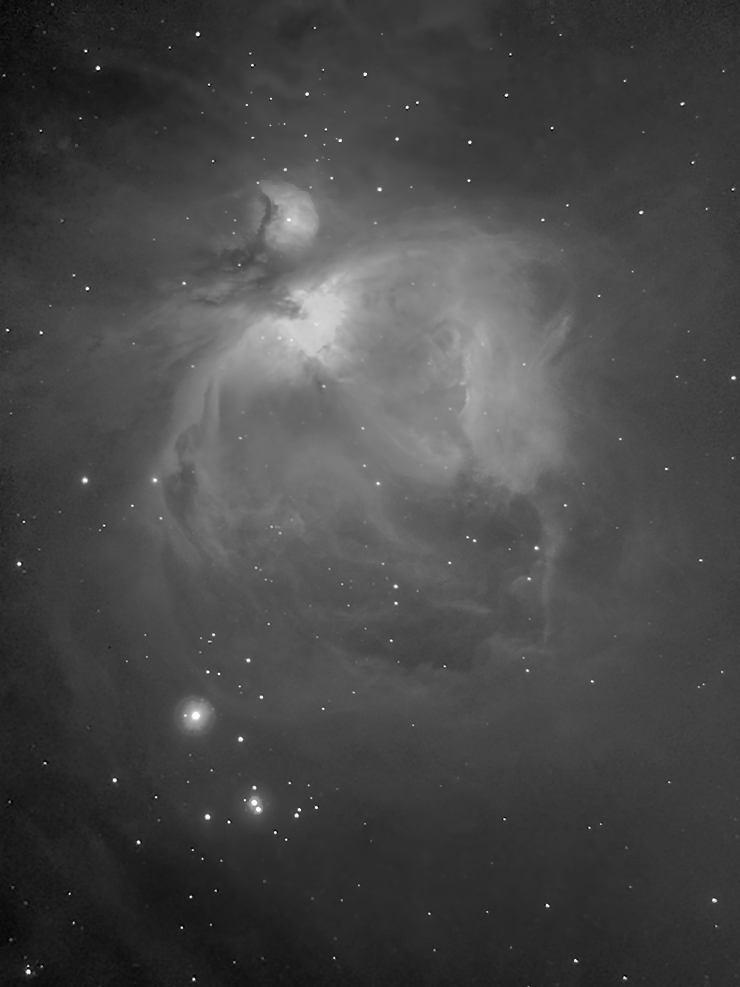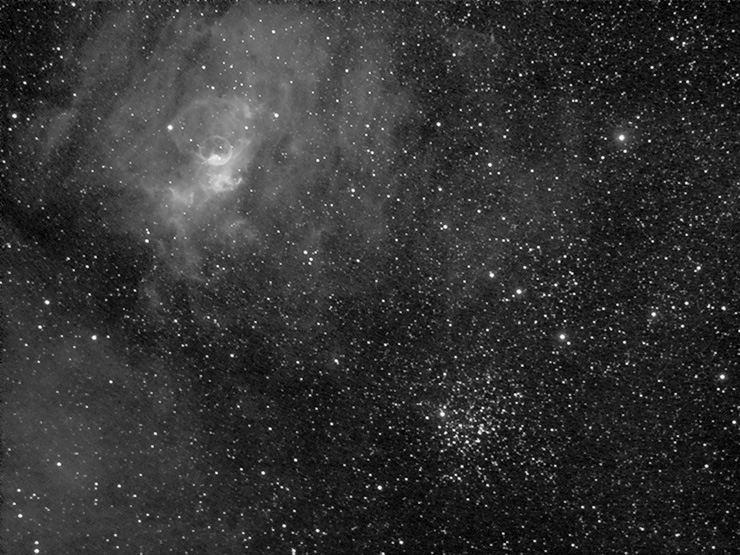|
12/24/2010 I began Christmas Eve by photographing the birth and death of suns. There is nothing allegorical or mystical about that: it is the literal truth. At midnight, I was photographing Messier 1, the Crab nebula, the wreckage of a star destroyed in the year 1054. Then I finished the night's session with several photographs of Messier 42, a huge, star-forming region in Orion. I began the evening before by taking a good cut at a nebula in Cassiopeia, where a very hot, very bright Wolf-Rayet star is blowing a bubble in space. The remains of a star, Messier 1:
Star-forming region Messier 42:
Star cluster Messier 52 and the Bubble Nebula in Cassiopeia:
Tech specs and notes for these three photos: All three are with the ST2000XM CCD camera behind the 5-inch F6 A-P refractor telecompressed to F4.3 (538mm effective focal length) using a FeatherTouch 0.8-inch fine-focus adapter. Image acquisition by Nebulosity 2.0 software. Alignment, calibration and color combination by Maxim 5.12. All were guided using a Meade DSI Pro behind an Orion ST80 using an Orion Shorty Barlow to produce an effective focal length of 1027mm. The main and guide telescopes were carried (of course) on my A-P Mach1 GTO mount. PHD Guide provided Rudolphine services. There was enough wind that PSF's were a little larger than usual, and I saw (on the guiding performance graph) infrequent full pixel excursions owing to gusts (of course, a full pixel excursion with the barlowed guider is equivalent to a 0.4 pixel excursion with the ST80 at its native focal length). Messier 1, the Crab Nebula in Taurus: a tri-color image made up of 2, 300s exposures through Baader blue and green filters and 5, 900s exposures through a Schuler 10nm hydrogen-alpha filter. I used an average of the deep-red H-a exposures for the red channel (weighted 2.6:1:1 to produce decent star colors; an algorithmic rebalancing scheme for this and future images wouldn't hurt). The image shown here is cropped and downsized from about 70% of the full frame. Messier 42, the Great Orion Nebula: the challenge is always to show both the brilliant inner details and the far fainter extensive outer structures. This is not an attempt to render maximum range or maximum detail or to mimic the visual experience -- worthy goals all. I just wanted to see what different exposures would show to advantage and in the end averaged all of the exposures in a first effort to render this bright and dim, huge and detailed, colorful and pale nebula.
After averaging all these into the full frame, I layered in an image produced from just the first two rows over the central regions. It's not the composite it will be (I needed another 900s exposure, or maybe two, but trees intervened; and the composite does not show the quadruple star at the core of the nebula clearly). Nor does it include any color data. When you're shooting through a narrow gap in the trees, you take what you can get. Messier 52 and NGC 7635: a bright star cluster and a faint nebula in Cassiopeia. 11, 900s exposures all through the H-a filter. The only thing out of the ordinary about this photo is that the first 6 images were made with the CCD cooled as intended to -40° but the thermoelectric cooling got switched off for the 7th through 11th frames. That necessitated a second dark frame at -3C (ambient air temperature) which I used to calibrate the photos made with the uncooled chip. The rescue was surprisingly effective, but it was unnecessarily exciting. I collected color data for this photo, but mixing the H-a and color frames is not trivial. By and by. There's a good bit more nebulosity in that field, but to do it justice I really should've shot a good flat. I need to put a flat diffuser together so I don't hesitate to do that. Here's a more aggressively stretched version of the photo above, but I make no guarantees that some of the extended nebulosity isn't actually some kind of gradient:
In the mail, a Mandel Muscle Plate arrived from Ontario amateur Paul Mortfield (for a good time, Google him). Seems good as new; it came with all the screws, setscrews and allen wrenches needed to install it. With this discontinued accessory from California entrepreneur Steve Mandel, the 2-inch adapter on the CFW-8a of my ST2000XM is held not only by the friction of the threads but by a robust setscrew. The plate is twice the thickness of the OEM plate. The CCD will not be tilting due to flexure or slipping on the adapter's threads with this thing in place.
|
:: top ::
© 2010, David Cortner



